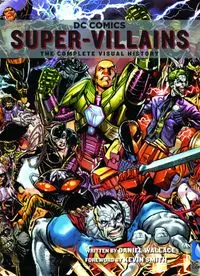
Super-Villains: The Complete Visual History PDF
Preview Super-Villains: The Complete Visual History
SUPER-VILLAINS SUPER-VILLAINS T H E C O M P L E T E V I S U A L H I S T O R Y W R I T T E N B Y D A N I E L WA L L A C E F O R E W O R D B Y K E V I N S M I T H San Rafael, California CONTENTS Foreword by Kevin Smith Introduction 08 10 01 Menaces of Metropolis 14 02 Gotham City's Rogues Gallery 38 03 Adversaries of the Amazing Amazon 70 04 Evil Overlords 78 05 Enemies of the Emerald Knight 92 06 Lives of Crime 100 07 Foes of the Fastest Man Alive 110 08 Mad Science 120 09 Monsters, Experiments, and Freaks 130 10 Strength in Numbers 146 Epilogue 158 FOREWORD ON BEING BAD If you're ever in conversation with someone who suddenly speaks with admiration about his or her favorite serial killers, walk away. Conversely, if you’re ever engaged on the subject of comic book baddies by a fan of such, buckle up for the show of a lifetime— because our type tends to speak with the eloquence of Socrates when discussing super-villains. We carefully measure psychotic deeds against questionable haute couture to arrive at a metric for our criminal affection that is so complicated (both mathematically and psychologically), it’d make Pythagoras quit numbers forever. When I was a kid on the school playground and my classmates were choosing who’d play which position in Wiffle Ball, I’d always wind up in left field—where no Wiffle Ball ever travels. Sports were not my thing: The world of cartoons and comic books was where I lived and breathed. So every afternoon, I pushed to play “Challenge of the Super Friends”—based on the Saturday morning cartoon renditions of all our favorite DC Super Heroes. It was this simple: If I could sway enough of my classmates to choose fantasy over the dopey tetherball line, we’d leave the athletics to the athletes and head for the Hall of Justice. Now, whenever Wiffle Ball bats were cast aside for Batman, it was my job to assign the roles. In a prototypical exercise of what would later become my profession (telling people to pretend to be someone else for a little while), I’d cast our lunchtime adventure based on my friends’ personalities. So Janine would be Wonder Woman. John would be Superman. Mike would be Batman. Chris would be Aquaman. But with the big guns spoken for, which role would the game master play? Each and every time we trod the boards as the Super Friends during grade school recess, I’d squeeze into an imaginary wet suit and become Black Manta. The Joker? Lex Luthor? Cheetah? Morons. My favorite villain in childhood had always been Black Manta. Black Manta’s creators gave him an elegant Darth Vader-ish black suit with giant, illuminated eyeholes. And as depicted in Challenge of the Super Friends, he spoke through a voice modulator—which made him sound like a bad guy, too. The faces of the other villains were uncovered, so you could see the greedy humanity and angry eyebrows employed to distinguish the bad guys and girls from their law-abiding counterparts. Manta’s face, however, was buried in a giant metal helmet, his humanity hidden completely, so you could easily imagine him as a deep-voiced killbot who swam with sharks. The Black Manta in Challenge of the Super Friends was the villain of choice for any kid who loved both Jaws and Star Wars. Thank Grodd we have comic book villains to assuage any real interest in being bad. And nobody does a Rogues Gallery better than DC Comics. Whether tragic victims of circumstance or evil incarnate, the villains of the DC Universe loom large throughout not just pop culture but the culture in general. In a world where even my mom could describe the Riddler for a police sketch artist, DC Comics super-villains have captured imaginations and built a big, bad brand that travels far beyond the fan base. And it’s fine to be a fan of these shimmering psychopaths, each colorful character more hell-bent on domination than the next. We have to quietly cheer them on—if for no other reason than to invoke the heroes who always vanquish these nefarious foes and fools. It’s omelets and eggs: You can’t have good guys without the bad guys. So as you flip through these pages, should you feel an inexplicable affinity for Captain Boomerang or Doomsday, it doesn’t mean you need to talk to a therapist or priest. Rooting for a DC Comics super-villain is half the fun of reading a DC comic book. And as long as the other half of the fun involves wanting the DC Super Heroes to bust with the justice and make it all better again, you’re doing it right. But if you hate Batman and love the Joker, seek help. —Kevin Smith
